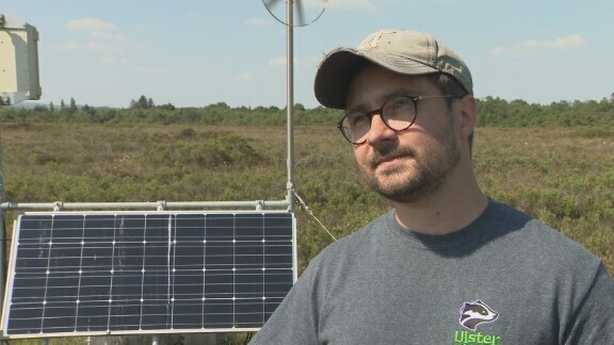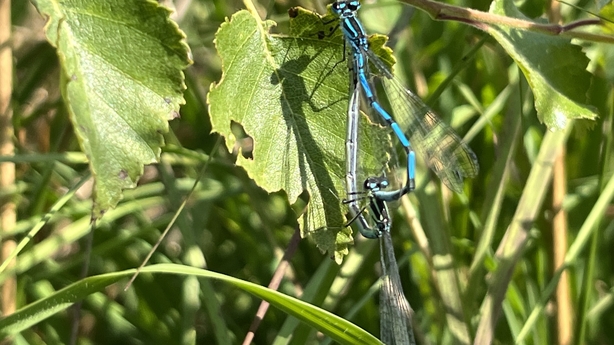There are almost 400 nature sites in Northern Ireland that are so precious, they are protected by law.
More than half of them - 250 - are vulnerable to being overloaded by airborne nutrients. Virtually all of those are in that position.
The problem is intensive agriculture and the slurry it produces.
Agri-food in Northern Ireland is a £5bn a year business and a mainstay of the economy.
But the dairy, pig and poultry sector is having a significant environmental impact.
Housing livestock generates large volumes of waste, which has to be disposed of.
And the chosen method for much of that - slurry spreading - is affecting sensitive sites across Northern Ireland.

One of them is Ballynahone Bog in south Derry.
It is a special place, buzzing with life.
While filming there, we saw dozens of damselflies and four spotted chaser dragonflies.
In the ponds, newts swam just below the surface and, every now and again, a swallow or swift would swoop in to take a drink of water on the wing.
But all the activity masks a fundamental problem.
Ballynahone, like other protected sites, is getting far too much airborne nutrients.
Conservationists whose job it is to monitor the site, say they have been recorded at up to six times the level it can accept.

The problem is nitrogen compounds, in the form of ammonia gas, linked to the spreading of slurry.
Nitrogen is a fertiliser and that upsets the balance of biodiversity on the nutrient poor bogland.
It encourages vigorous growth of things like grasses, which crowd out delicate plants like the bog rosemary - one of the reasons that the site is protected.
But it also has a much more fundamental impact on the bog, as Simon Gray of Ulster Wildlife, who monitors the site, explains.
"The things that we start to see lose out are the most sensitive species. So the sphagnum mosses, which are the building blocks of peatland, they actually start to break down when there are high levels of ammonia here," Mr Gray said.
"They'll get a film of algal growth over the top of them and they start to turn into jelly and eventually turn into mush."

The Stormont department that looks after the environment also has responsibility for agriculture.
In 2017, its experts issued guidelines for planners on how to assess applications for livestock housing in light of the ammonia situation.
However, a member of the public raised a complaint and now the UK's top environmental watchdog has been called in to investigate.
Prior to Brexit, oversight of environmental law in Northern Ireland was ultimately a matter for the EU.
After Brexit, a new governance arrangement was needed.
The UK created the Office of Environmental Protection to hold public bodies in England and Northern Ireland to account.
It is only just up and running, but its first investigation is into the adequacy of Northern Ireland's planning guidelines around ammonia, what it calls the "operational protocol".

"We received a number of complaints from a member of the public here in Northern Ireland in relation to individual planning decisions that had an ammonia impact," says OEP chief executive Natalie Prosser.
"And drawing together those complaints we identified a root cause issue in the operation protocol, we were concerned that it might breach environmental law and hence we launched this investigation.
"Agriculture is an incredibly important part of the economy and we completely understand that. What we're concerned about is making sure that in that context the environment is protected as well.
"We're not anti-farmer but we are very much pro-environment, it's about making sure that those decisions are made in compliance with the underlying law which seeks to achieve a good balance between those two pressures."

All this has placed farmers in a very difficult position.
The ammonia guidelines have effectively been parked while all this is sorted out, meaning applications for things like new poultry houses are now stuck in the system.
The Ulster Farmers' Union has complained that the decision will hold back the industry, preventing it from replacing outdated livestock housing with more modern facilities which would emit less ammonia.
"To say our farmers are frustrated is an understatement," says the union's president David Brown.
"Stagnating farm developments across Northern Ireland impacts all sectors and farms of all sizes and will have wide reaching implications."
Stormont's Agriculture and Environment department has been grappling with the ammonia issue for years.
Public consultation on a new draft ammonia strategy has closed.
It suggests ways of cutting emissions by encouraging measures like the covering of slurry stores and the widespread adoption of low emission slurry spreading.
It is estimated that could cut ammonia emissions across Northern Ireland by 25%.
But environmentalists point out that that would only help a handful of the vulnerable protected sites.
They say much greater ambition is needed.








